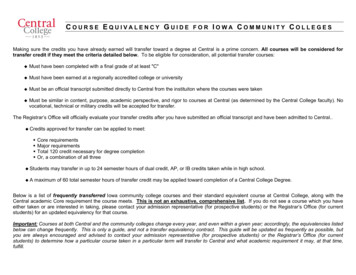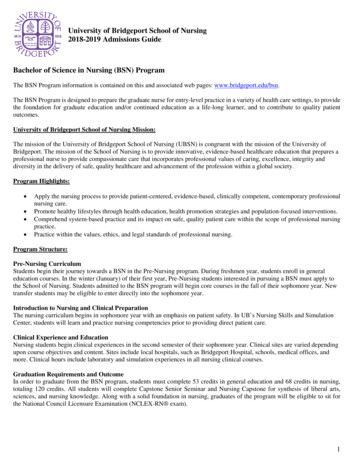
Transcription
Wise Business BasicsBusiness PlanAnatomy 101apublication
All rights reserved. No part of this publication may be reproduced in any formor by any means graphic, electronic or mechanical including recording, photocopyingor by any other information storage or retrieval system, without the written consentof the publisher. This publication is sold as an educational reference only. While allattempts have been made to verify information provided in this publication, neitherthe author nor the Publisher assumes any responsibility for errors, omissions or contraryinterpretation of the subject matter herein. This publication is not intended for use asa source of legal or accounting advice. The Publisher wants to stress that the information contained herein may be subject to varying state and/or local laws or regulations.All users are advised to retain competent counsel to determine what state and/or locallaws or regulations may apply to the user’s particular business. The purchaser or readerof this publication assumes responsibility for the use of these materials and information. The author and Publisher assume no responsibility or liability whatsoever on thebehalf of any purchaser or reader of these materials. We expressly do not guaranteeany results you may or may not get as a result of following our recommendations.COPYRIGHT 2016 Wise Business Plans
3 W I S E B U S I N E S S B A S I C S : B U S I N E S S P L A N A N AT O M Y 1 0 1CONTENTS1 Introduction.52 Mission Statement.63 Executive Summary & Financial Overview.74 Products and Services.95 Market Analysis & Summary. 106 Branding and Marketing. 127 Competitive Analysis. 148 Marketing Campaign. 169 Exit Strategy. 1810 Return on Investment. 1911 Milestones. 2012 Management . 2117 Financials. 2318 Appendix. 25
“The object of all work isproduction or accomplishmentand to either of these endsthere must be forethought,system, planning, intelligence,and honest purpose, as well asperspiration. Seeming to do isnot doing.”—Thomas Edison
5 W I S E B U S I N E S S B A S I C S : B U S I N E S S P L A N A N AT O M Y 1 0 1Welcome to SuccessCreating a businessplan can be one ofthe most dauntingparts of startinga new venture —even if you’re working with aprofessional. Even seasonedmanagers with a wealth ofexperience in their chosen fieldscan find themselves strugglingto jump in to this all-importantprocess. For those with a greatidea and but limited businessbuilding experience, it can beespecially difficult to make theleap and start planning.Wise Business Plans has beenyears smoothing this process andmaking it less overwhelming forbusiness owners and managers.But it can still be hard to committo creating a business planwhen you simply don’t knowwhat you’re getting into. Andsome clients find that theyreally feel the need to work on aplan themselves before seekingprofessional assistance.more in the know.In this guide, we’ve workedcarefully to take some of themystery out of what goes into agood plan. It’s still an involvedprocess, and chances are you’llwant help along the way. Butknowing the different sectionsand some of the basic businessdefinitions involved can helpyou feel more in control andAnd, as always, if you havequestions, please visit us andWiseBusinessPlans.com or dropus a line at info@wisebusinessplans.com — we stand readyto serve.We’ve taken an overwhelmingamount of information andtrimmed it down to its most vitalpoints and pieces, caressing aguide that tells you everythingyou need to know about theanatomy of a business plan inour classic no-nonsense style.
6 W I S E B U S I N E S S B A S I C S : B U S I N E S S P L A N A N AT O M Y 1 0 1Mission StatementYour mission statement is not only a declaration to the worldabout what your company is and hopes to do; it’s also a headingfor you and your partners and employees, providing a way tore-center and refocus on the road to success. A strong, clearmission statement provides a heading and a metaphorical flag thatyour company can use to rally around.But what makes a good mission statement, and is one really necessary? While the answer tothe first part of the question is complicated, the second answer is an emphatic YES!A strong, useful mission statement will tell:A) What your company was created to accomplishB) Who it’s hoping to serve by reaching its goalsC) How it fulfills that service promiseD) And the value providedIf you’ve done any kind of basic planning and brainstorming about the foundation of thekind of company you hope to shape, you’ll have some of this information at your fingertips.Discovering the remaining answers is an incredibly useful process that demonstrates just howvaluable creating a mission statement can really be.While established companies can sometimes afford to skate by without a current missionstatement — or, worse, several different versions — you won’t have that luxury as a small businessowner or an entrepreneur looking to launch a new venture. You need potential investors (andpotential partners or employees) to know, at a glance, what you stand for and what you do.In light of that fact, keep your mission statement short and to the point, without leaving anyimportant information out.If that sounds difficult, well, it can be. Writing a mission statement is an artform in and of itself.But if you can sit down and answer the hows, whats and whys of your company’s genesis in acouple of clearly written sentences, you’re further along than many beginning entrepreneurs,and you’ve competed the first step in preparing to craft your business plan.
7 W I S E B U S I N E S S B A S I C S : B U S I N E S S P L A N A N AT O M Y 1 0 1Executive Summary& Financial OverviewThe executive summary sets the tone and direction for your plan,allowing you to introduce the key information you’ll be reviewingwhile also introducing yourself and your business vision.Know your audience, and try to work with your plan writer — or an editor, if you’rewriting a plan yourself — to ensure that the voice that comes through from the pageis the voice of the business you’re hoping to build. Always remember that you arespeaking directly to potential investors through your executive summary but youare also providing a window into the way you want to do business. So be polite, beengaging, but be true to who you are and what you want your company to be.On the flip side, it’s often smart to target this particular portion of your plan, in someway, toward the kind of investors you hope to approach or attract. So do your researchbeforehand, and be prepared to offer an overview of your company that shows howit fits the needs of the people you want to draw onboard.The language used in your summary should be clear, well-edited and to the point.Think of your executive summary as a strong, expanded outline of your full plan. Itshould tell or offer readers: The basics, like the name of your business, its location and its web address The problem your company will solve A general glimpse of what your business concept is The basic competitive landscape facing your company The market you’re looking to serve Who will make up your management team, will brief explanations aboutqualifications The company’s present stage of development A snapshot of your financial condition
8 W I S E B U S I N E S S B A S I C S : B U S I N E S S P L A N A N AT O M Y 1 0 1Two of the important financial overviews included in this portion of your business planwill be an overview of financial objectives and a start-up or expansion summary. Thefinancial overview consists of a table and graphs illustrating the financial goals of yourcompany during the next five years. The start-up or expansion summary tables andgraphs detail the funding the business will need to bring the vision to reality. Start-upfunding includes all the expenditures, both start-up assets and start-up expenses,incurred before the company starts earning revenue.If you’re just starting out, and you don’t have some of the details available that anestablished company would, then remember that, at this stage, you’re really sellingyour own experience, vision and ability to make things happen. So focus on your goals,your talents, your experience and — most important — the steps you plan to take toreach those goals in your summary.Remember: Your executive summary is your chance to make a great first impressionon potential investors. Make sure the opportunity it offers isn’t wasted. Offer solid,useful information in an easy-to-read format. Keep it relatively short (one to two pages,not counting the subsequent charts and financial snapshots), and, if you’re writing abusiness plan yourself, consider making the executive summary your last step. Thiswill allow you to draw on the rest of the plan as inspiration.
9 W I S E B U S I N E S S B A S I C S : B U S I N E S S P L A N A N AT O M Y 1 0 1Products & ServicesThis may seem self-explanatory, but it’s surprising how manypeople fail to fully explain exactly what they’re offering whencreating their business plans.The products and services section of your plan should be as detailed as possible.Include photos, color options, sizes, specs, fabric detailing, pricing for services, fullmenus — the more information you can provide — and the more engaging it is — thebetter you sell your concept. And, as a bonus, any work you put into this section nowwill pay off later, when you’ll need product images and copy to create compellingmarketing materials.Think of this section as your opportunity to really sell your end-product, whether it’sa concrete, in-your-hand item or an experience. If you’re working with a business planwriter, help him or her understand what you’re looking to offer by being as detailedand descriptive as you can. Err on the side of more information, not less, and allowthe writer to decide how much to include. (Of course, speak up if you think somethingimportant has been left out!) From a design standpoint, try to provide high-resolutionimages of actual products or a vivid, detailed description of your services that can betranslated into eye-catching art to draw readers into your plan.While this section should paint a picture for readers, it shouldn’t get bogged down inoverly technical language or jargon. As with the rest of your plan, the writing shouldbe clean and easy to follow.While this isn’t really the spot to browbeat your competition, it is the right place tomake a case for how your products or services stand out. Anything that is different,better, new or unusual (in a good way) about what used got to offer should be emphasized and showcased in this part of your plan.If you have endorsements, design awards or other accolades, this is a good place toshowcase them.
1 0 W I S E B U S I N E S S B A S I C S : B U S I N E S S P L A N A N AT O M Y 1 0 1Market Analysisand SummaryIn-depth knowledge of relevant markets is what takes a entrepreneur and turns him or her into a savvy, experienced and successfulbusiness owner. Without an understanding of the environment youhope to thrive in, you’re destined to meet obstacles and unpleasantsurprises that can hinder or even reverse any gains you make. That’swhy a strong, well-written and meticulously researched market analysisis at the heart of a solid business plan.The information, research and statistical analyses completed and share within thissection of your plan will differ depending upon the markets and industries yourcompany fits within, and you may have specialized sub-sections, such as a trendsanalysis, that wouldn’t apply to a plan for a business in another industry. But some ofthe most common sub-sections in the market analysis summary include:Market SizeThis information is crucial. Are you looking to be a big fish in a small market or a thrivingniche player in a large field? So many things hinge on your market size — from therequired pace of innovation to the direction and degree of your initial promotionalefforts, the pool of people from which you’ll draw your company’s support and audienceaffects almost every aspect of your launch and future success.Market SegmentationSegmenting your market into key groups allows you to tailor your approach and focuson those consumers within the core who will be most likely to respond to what you haveto offer. This is kind of a forest-and-trees situation: While you may, at first, view yourmarket as one solid group that thinks and acts alike, almost any group of individualscan be sifted and categorized in some meaningful way.
1 1 W I S E B U S I N E S S B A S I C S : B U S I N E S S P L A N A N AT O M Y 1 0 1LocationEven if your company is online only, these days, the digital realm is a “location” in itsown right, with all the attendant plusses and minuses, and you’ll want to a review andanalysis of what those are within your business plan. If you are looking to operate outof a brick-and-mortar office, however, and market to a segment of the population in thevicinity of that location, then this section takes on even more significance. You’ll needinvestors — and company leaders — to understand where you plan to do business inorder to serve the customers and clients who call that same space home.Location: DemographicsPaired with the information in the previous sub-sections, a demographics analysis addsdeep insight into the backgrounds, interests, socioeconomic statuses and behaviors ofyour potential customers and clients. This kind of “X-ray vision” into your market allowsyou to make smarter choices about their needs, wants, desires and future purchasingdecisions.Target marketOne of the most important things you need to know about your business is who yourtarget market includes. You’re not only identifying your customers or clients, buthelping them to identify you, by more clearly defining your company and its objectives. Tailoring your advertising and researching your market will help both yourbusiness and your customers, because you’ll be better able to show them how they canbenefit from what you have to offer. This sub-section helps define that target marketfor potential investors.Market NeedsOne big task of your business plan, as a whole and in particular sections, is to demonstrate the problem that your company will solve or the need it will meet. This is one ofthe best places for making the case for you business as the answer to what’s missing inyour target market. This sub-section will offer details about what’s presently lacking incompetitors’ offerings and strongly offer evidence and details about how your companyerases that gap by filling it with the services or products you’ll have to offer.
1 2 W I S E B U S I N E S S B A S I C S : B U S I N E S S P L A N A N AT O M Y 1 0 1Branding andMarketingThis section, though often no more than a page in length, is avital part of your planning process.Branding is absolutely key to the success and growth of any business -- it’s your company’s identity, and the metaphorical vessel that holds your reputation, the consumer’sknowledge of what you have to offer and every bit of information the public hasavailable to judge your integrity, your ability to innovate the quality of what you canprovide. A brand is more than just a logo and some signature colors. It’s the face and,some might say, the soul of your company, distilled.Maintaining a well-regarded brand is, therefore, vital to the health of your company,and you need to show that you understand that fact when approaching potentialinvestors. Not only will this help you demonstrate you commitment to branding, it willalso give your brand itself a head-start, planting the seeds of customer loyalty and andword-of-mouth advertising opportunities.Of course, one of the best ways to grow and establish a fledgling brand is to nurture itby taking steps to create a truly positive corporate image. This can be accomplished ina variety of ways, from community outreach efforts to supporting s charity. However,
1 3 W I S E B U S I N E S S B A S I C S : B U S I N E S S P L A N A N AT O M Y 1 0 1one of the easiest and most useful ways to create positive buzz is to make an uncompromising commitment to providing products and services of the highest quality.Within your professional-quality business plan, the Branding & Marketing sectionwill contain and introductory statement and quick-hit lists of objectives and keys tosuccess. These will include items like:Objectives Becoming a leader in your industry Focusing on customer service Creating brand awareness Maintaining certain profit margins Keeping abreast of changes in the marketplace Making changes to product and service offerings to keep in linewith industry trendsKeys To Success High-quality product presentation Strong branding Smart hiring Strategic choice of physical location in a high-traffic area On-trend products/services Strong relationships with vendors Excellence in customer service Careful resource management Reinforcement of a positive industry imageDon’t be tempted to skimp on the points made in this item. Make sure they’re trulyapplicable to your situation, and commit to following through on them.
1 4 W I S E B U S I N E S S B A S I C S : B U S I N E S S P L A N A N AT O M Y 1 0 1CompetitiveAnalysisRegardless of how unique your concept is, you’re going to facesome form of direct or indirect competition.Your competitor may be down the road or across the globe; today’s easy internet eachand-shop culture means the world of commerce is smaller than ever. This section ofyour business plan will need to offer investors several kinds of honest assessments ofthe kind of field you’ll be facing.Don’t over- or underplay the strength of other contenders in your industry or market.Implying that you have little to no competition can set you up to underperform andleave you unprepared to fight for your rightful marketshare.Sub-sections you can expect to be included in this part of your plan include:A Local Competitive AnalysisThis is exactly what it sounds like, but it may be more in-depth than you expect. Whileyou won’t be receiving (or writing, for the do-it-yourselfers) an essay on each localcompetitor, the chart contained in this sub-section should outline each local competitor’s strengths and weaknesses, target market, basic contact information and facts (suchas its date of founding), and any other information that may useful for comparisonpurposes. The same information will be listed for each local player, allowing readersto review them head-to-head.A List Of Major Industry PlayersThis sub-section expands the concept of the Local Competitive Analysis, while changingthe structure of a bit. The Major Industry Players chart often drops the basic contactinformation — less important when coupled with a lack of proximity -- in favor of amore in-depth, paragraph-structured overview of the competitor’s history and productor service offerings. Again, in the Internet Age, distant competitors — particularlythose leading your industry — are a viable threat that must be analyzed and overcome.
1 5 W I S E B U S I N E S S B A S I C S : B U S I N E S S P L A N A N AT O M Y 1 0 1A List Of Your Company’s Competitive AdvantagesThis is the place to showcase the factors that allow you to compete head-to-head withothers in your industry. This sub-section typically takes the form of a list, and it shouldbe detailed and very specific to your company. For example, rather than simply listingsomething akin to “Year of executive experience,” this list will include details, such asthe company founder’s specific year’s of experience and competencies. Other itemsoften listed here include company specializations, mention of niche markets and pointsabout the ways your products and services stand apart.Barriers To EntryEvery industry will have some level of barriers to entry. This sub-section classifies thosebarriers into low, mid-level or high and offers detail on hat they are and, if possible,how your company can overcome them. Barriers to entry that are common across manyindustries include high start-up costs, a crowded industry, and difficulties creatingbrand awareness.SWOT AnalysisThe SWOT in SWOT analysis — or SWOT matrix, in some plans — stands for strengths,weaknesses, opportunities, and threats, and that’s exactly what it evaluates and putsforth for the reader. Listed within a grid, with Strengths and Opportunities on the leftand Weaknesses and Threats on the right, the SWOT analysis is an incredibly valuabletool not only for demonstrating the viability of your concept to investors, but also forevaluating any concept at any stage of development. It can even be used to evaluatea potential hire, or a proposed advertising campaign. The SWOT paradigm forcesits creator -- and the reviewer -- to think in terms of balance and consider whetherweaknesses and threats can truly be overcome. Expect this sub-section to have bothgeneral and specific items, relating to your company individually and your industry.Risk AnalysisWhen coupled with the SWOT analysis, the risk analysis completes the portrait of theobstacles in the way of your companies success and, if done right, instills faith in thereader that you can overcome them and thrive. The risk analysis, typically about aparagraph in length, evaluates the risks of your company specifically, and takes intoaccount things like projected overhead costs, your specific competitive landscapeand the effects of your industry’s level of barriers to entry on the intensity of thatcompetition.
1 6 W I S E B U S I N E S S B A S I C S : B U S I N E S S P L A N A N AT O M Y 1 0 1MarketingCampaignMost small business owners understand going in, at leastin a general way, that marketing is vital to establishingand growing their company.After all, as we’ve often said, it’s nearly impossible for someone to take advantage ofwhat you’re offering if they don’t even know you exist. In today’s crowded advertisingand marketing landscape, there are multiples channels and sub-channels ready andwaiting for you to utilize them as a vehicle for your marketing message. Of course, someare free, and others are costly enough to give some small business owners pause. Thegoal of the marketing campaign section of your business plan is to lay out a strategyfor utilizing a balance of paid and unpaid channels in order to spread the word aboutyour company as far and as wide as possible.For the most part, avenues and opportunities for marketing are fairly universal, thoughnew ones pop up every day. Investors will want to see that you have a nice range oftraditional (such as print) and cutting edge opportunities that you plan to take advantage of. Some common sub-sections within a marketing campaign include:NetworkingNetworking is a relatively easy, even enjoyable way to form new business connectionsand partnerships. While it is in some cases free, it can be helpful to pay for memberships to networking groups to ensure that you’re connecting with like-minded peoplewho are also looking to network. This sub-section may detail some of the ways yourcompany will take advantage of networking opportunities to market what it has to offer.Email MarketingEmail marketing, once avant-garde, is now a staple of the marketing tool kit and isvitally important to the success of any business in the digital age. Different kindsof email campaigns utilized may include digital newsletters, drip marketing seriesemails, weekly tips and pointers or discounts, coupons and specials sent directly tosubscribers’ inboxes.
1 7 W I S E B U S I N E S S B A S I C S : B U S I N E S S P L A N A N AT O M Y 1 0 1Direct SalesNever underestimate the power of a good, old-fashioned direct-sales team. If yourmarketing campaign includes a sub-section on direct sales, it will include informationon whether you’ll be hiring a dedicated sales team or outsourcing sales calls, and whatthose calls might entail.Social MediaThe importance of a strong company presence on social media sites like Facebook,Instagram, Twitter and LinkedIn can’t be stressed enough. This sub-section will touchon the social media channels within which your company expects to maintain an activepresence.News ReleasesWhile the landscape of news delivery is in flux these days, the classic news or pressrelease is still a powerful tool, made even more useful in the age of instant digitaldistribution. A strong news release can garner your company the right kind of publicityand spark invaluable word-of-mouth advertising. It may be useful to offer short detailsabout media markets you hope to approach in this space.Trade ShowsWhile not all companies will take advantage of trade show and convention opportunities, if you plan to do so, make that clear here, and list specific events you may attend,if applicable.WebsiteThese days, a company without a website is really missing out on enormous opportunities, so it’s safe to assume you’ll want to list one here. Include your site’s URL, alongwith any information on how you plan to utilize content marketing on the site to getthe word out about your company and what it offers.
1 8 W I S E B U S I N E S S B A S I C S : B U S I N E S S P L A N A N AT O M Y 1 0 1Exit StrategyNo new business owner really likes to think of his or herfledgling, newborn business shutting down or passinginto someone else’s hands. But selling your company canactually be a wonderful thing, when it goes on to grow for someoneelse, and both parties benefit.In any case, knowing how you and investors will recoup your money inthe event that the business changes hands or closes is actually extremelyimportant, especially to outside contributors.The common strategies listed typically include:Repayment: The company chooses to remain a privately owned enterpriseand repays its investors in full, consolidating ownership in the Founder.Buyout: Your company, as a successful income-generating operation, experiences growth and sees the opportunity to expand its brand into additionalmarkets. Competing brands begin to take notice of the Company. Thesebusinesses approach with attractive buyout offers, and the Company negotiates and sells to the best deal.Merger: Your company merges with another company to expand its marketreach and development capabilities.Business Ceases: Your company liquidates all assets, pays its debts, repaysinvestors, and ceases business activities.IPO: The Company sells its equity through the sale of stocks on the openmarket. As a public company, your business will enjoy increased exposureand prestige, helping it to attract and retain the most talented executivesand employees.
1 9 W I S E B U S I N E S S B A S I C S : B U S I N E S S P L A N A N AT O M Y 1 0 1Return onInvestment (ROI)Return on investment — ROI — provides a unit of measure for theprofitability of an investment. It’s most commonly calculated usingthe formula ROI [(gross profit – investment) / investment] x 100.ROI is a useful section to include in plans for expanding companies, as it offers a wayfor potential investors to understand what they may be getting in return for theirmoney in the future.The ROI section will contain both charts and information in paragraph form, explaining: The present and future monetary values the company’s managers have estimatedfor it, based on net assets and industry multipliers The amount of equity investment the company is seeking How management expects to increase the value of shares in the company The estimated monetary total of the overall return expected from the fundingamount requested How soon management expects investors to be able to get a return on theirshares
2 0 W I S E B U S I N E S S B A S I C S : B U S I N E S S P L A N A N AT O M Y 1 0 1MilestonesWriting the milestones section is sometimes tricky forthose creating business plans for themselves. It can bedifficult to decide how broad or detailed to be in yourmilestones timeline.On the one hand, you don’t want to bog your reader down in minutiae, causing thedates and times listed to blur together and lose impact. However, you also don’twant to make the common beginner mistake of just listing one milestone — “GRANDOPENING!” — on your charts.If you receive a professionally written business plan, this section is often fairly short,consisting of one page with an easy-to-read, chronological chart (or set of charts) anda disclaimer noting that management reserves the right to change milestones andtheir dates. Common business milestones listed include: Obtaining Funding Securing and Renovating a Location Hiring Employees Opening for Business Achieving a certain level of gross salesA manager for each step of the process is designated, and timeframes and deadlinesfor completion are given.
2 1 W I S E B U S I N E S S B A S I C S : B U S I N E S S P L A N A N AT O M Y 1 0 1ManagementEven a sole proprietorshi
8 WISE BUSINESS BASICS: BUSINESS PLAN ANATOMY 101. Two of the important financial overviews included in this portion of your business plan will be an overview of financial objectives and a start-up or expansion summary. The financial overview consists of a table and graphs illustrating the










